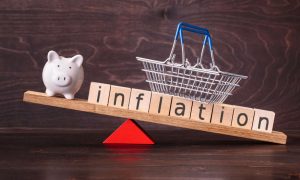What is inflation?
Inflation is an economic trend in which prices for goods and services rise over time. The Federal Reserve uses different price indexes, including the Consumer Price Index, to track inflation and determine how to shape monetary policy. Generally speaking, the Fed targets a 2% annual inflation rate as measured by pricing indexes.
Rising demand for goods and services can trigger inflation when there’s an imbalance in supply. This is known as demand-pull inflation. Cost-push inflation occurs when the price of commodities rises, pushing up the price of goods or services that rely on those commodities.
Inflation can have both pros and cons for consumers and investors. Understanding the potential effects of inflation can maximize the positives while minimizing the negatives.
Is Inflation good or bad?
Answering the question of whether inflation is good or bad means knowing more why inflation matters so much. The Federal Reserve takes an interest in inflation because of how it relates to the broader economic and monetary policy.
Some level of inflation in an economy is normal, and an indication that the economy is continuing to grow. While inflation has remained relatively low over the past decade, it has historically seen the most change during or right after recessions.
The Fed believes that its 2% target inflation rate encourages price stability and maximum employment.
Broadly speaking, high inflation can make it difficult for households to afford basic necessities, such as food and shelter. When inflation is too low, that can lead to economic weakening. If inflation trends too low for an extended period of time, consumers may come to expect that to continue, which can create a cycle of low inflation rates.
That sounds good, as lower inflation means prices are not increasing over time for goods and services. So consumers may not struggle to afford the things they need to maintain their standard of living. But prolonged, low inflation can impact interest rate policy.
The Federal Reserve uses interest rate cuts and hikes to keep the economy on an even keel. For example, if the economy is in danger of overheating because it’s growing too rapidly or inflation is increasing too quickly, the Fed may raise rates to encourage a pullback in borrowing and spending.
Conversely, when the economy is in a downturn, the Fed may cut rates to try to promote spending and borrowing. When both inflation and interest rates are low, that may not leave much room for further rate cuts in an economic crisis, which may spur higher employment rates. If prices for goods and services continue to decline, that could lead to a period of deflation or even a recession.
So, is inflation good or bad? The answer is that it can be a little of both. How deeply inflation affects consumers or investors–and who it affects most–depends on what’s behind rising prices, how long inflation lasts, and how the Fed manages interest rates.
Who benefits from inflation?
The Federal Reserve believes some inflation is good and even necessary to maintain a healthy economy. The key is keeping inflation rates at acceptable levels, such as the 2% annual inflation rate target. Staying within this proverbial Goldilocks zone can result in numerous positive impacts for consumers and the economy in general.
Inflation pros
Sustainable inflation can yield these benefits:
- Higher employment rates and steady paychecks for workers
- Continued economic growth
- Potential for higher wages if employers offer cost-of-living pay raises
- Cost-of-living adjustments for those receiving Social Security retirement benefits
The danger, of course, is that inflation escalates too rapidly, requiring the Federal Reserve to raise interest rates as a result. This increases the overall cost of borrowing for consumers and businesses.
Who is inflation good for?
Inflation can benefit certain groups, depending on how it impacts Fed shapes monetary policy. Some of the people who can benefit from inflation include:
- Savers, if an interest rate hike results in higher rates on savings accounts, money market accounts or certificates of deposit
- Debtors, if they’re repaying loans with money that’s worth less than the money they borrowed
- Homeowners who have a low, fixed-rate mortgage
- People who hold investments that appreciate in value as inflation rises
Who does inflation hurt the most?
Some of the negative effects of inflation are more obvious than others. And there may be different consequences for consumers versus investors.
Inflation cons
In terms of what’s bad about inflation, here are some of the biggest cons:
- Higher inflation means goods and services cost more, potentially straining consumer paychecks
- Investors may see their return on investment erode if higher inflation diminishes purchasing power, or if they’re holding low-interest bonds
- Unemployment rates may climb if employers lay off staff to cope with rising overhead costs
- Rising inflation can weaken currency values
Inflation can be particularly bad if it leads to hyperinflation. This phenomenon occurs when prices for goods and services increase uncontrolled over an extended period of time. Generally, this would mean an inflation growth rate of 50% or more per month. While hyperinflation has never happened in the United States, Zimbabwe experienced a daily inflation rate of 98% in 2008.
Who is inflation bad for?
The negative impacts of inflation can affect some more than others. In general, inflation may be bad for:
- Consumers who live on a fixed income
- People who plan to borrow money if higher interest rates accompany the inflation
- Homeowners with an adjustable rate mortgage
- Individuals who aren’t investing in the market as a hedge against inflation
Inflation and higher prices can be detrimental to retirees whose savings may not stretch as far, particularly when health care becomes more expensive. If the cost of living increases but wages stagnate, that can also be problematic for workers because they end up spending more for the same things.
How to invest during times of inflation
While inflation is an investment risk to consider, smart investing can minimize its impact on your portfolio. While savings accounts may yield more interest if the Fed raises interest rates, investing in stocks, exchange-traded funds (ETFs) or mutual funds could generate even higher returns.
Real estate and Treasury-Inflation Protected Securities (TIPS). Government-issued securities designed to generate consistent returns regardless of inflationary changes, can also be good buys during periods of rising inflation. If prices are rising, that can increase rental property incomes. You could benefit from that by investing in real estate ETFs or real estate investment trusts (REITs) if you’d rather not own property directly.
In general, compounding interest and the benefits of dollar-cost averaging over time can also help offset inflation. Compounding interest allows you to earn interest on your interest, which is key to building wealth. Dollar-cost averaging means investing continuously, whether stock prices are low or high. When inflationary changes are part of a larger shift in the economic cycle, investors who dollar-cost average can still reap long term benefits, despite rising prices.
The takeaway
Inflation is unavoidable but you can take steps to minimize the impact to your personal financial situation. Building a well-rounded portfolio of stocks, ETFs and other investments is a smart strategy for keeping pace with rising inflation.
The post Is inflation a good or bad thing for consumers? appeared first on Mediafeed.org
Original source: Mediafeed.org






